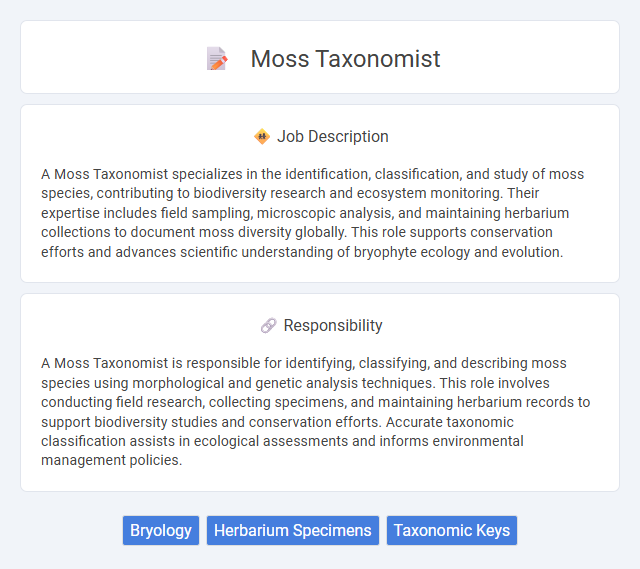
A Moss Taxonomist specializes in the identification, classification, and study of moss species, contributing to biodiversity research and ecosystem monitoring. Their expertise includes field sampling, microscopic analysis, and maintaining herbarium collections to document moss diversity globally. This role supports conservation efforts and advances scientific understanding of bryophyte ecology and evolution.
Individuals with a strong interest in botany and a meticulous nature are likely suitable for a Moss Taxonomist role, as it requires detailed examination and classification of moss species. Those who demonstrate patience and enjoy fieldwork in diverse environments may find this job fulfilling and aligned with their skills. People lacking attention to detail or a passion for ecological studies might face challenges adapting to the demands of this position.
Qualification
A Moss Taxonomist requires a strong background in botany, particularly bryology, with expertise in moss identification and classification. Advanced degrees such as a Master's or Ph.D. in plant sciences or ecology, combined with fieldwork experience in diverse habitats, are essential. Proficiency in microscopy, molecular techniques, and knowledge of regional floras enhances accuracy in species determination and contributes to biodiversity research.
Responsibility
A Moss Taxonomist is responsible for identifying, classifying, and describing moss species using morphological and genetic analysis techniques. This role involves conducting field research, collecting specimens, and maintaining herbarium records to support biodiversity studies and conservation efforts. Accurate taxonomic classification assists in ecological assessments and informs environmental management policies.
Benefit
The role of a Moss Taxonomist likely offers benefits such as contributing to biodiversity conservation and enhancing ecological research. There is a strong probability of gaining specialized knowledge in bryology, which can lead to academic and environmental career advancement. This job may also provide opportunities for fieldwork in diverse natural habitats, supporting environmental monitoring and preservation efforts.
Challenge
The role of a Moss Taxonomist likely involves complex challenges related to distinguishing subtle morphological differences among species, which requires meticulous attention to detail and advanced expertise. The task may often demand extensive fieldwork in diverse and sometimes remote environments, adding logistical and environmental difficulties. Identifying new species or clarifying taxonomic ambiguities probably involves integrating molecular analysis with traditional classification methods, posing significant scientific and analytical challenges.
Career Advancement
Moss taxonomists play a critical role in classifying and identifying moss species, contributing to ecological research and biodiversity conservation. Career advancement opportunities include roles such as senior taxonomist, research scientist, or academic positions, often requiring advanced degrees and published research in bryology. Expertise in molecular taxonomy and involvement in international botanical projects can further accelerate professional growth and recognition in the field.
Key Terms
Bryology
A Moss Taxonomist specializes in identifying and classifying moss species within the field of Bryology, contributing to the understanding of biodiversity and ecosystem functions. Expertise in microscopic analysis, molecular techniques, and fieldwork enables accurate species differentiation and phylogenetic studies. Research outcomes support conservation efforts and inform ecological assessments related to moss populations.
Herbarium Specimens
Moss taxonomists specialize in the classification and identification of bryophyte species using herbarium specimens as primary reference materials. They analyze morphological traits, record collection data, and contribute to the curation and digitization of moss samples in herbarium collections. Their work supports biodiversity research, ecological studies, and conservation planning through accurate species documentation.
Taxonomic Keys
Moss taxonomists specialize in the identification and classification of bryophyte species using taxonomic keys, which are essential tools for accurately distinguishing mosses based on morphological traits. These keys guide researchers through hierarchical choices involving leaf shape, cell structure, and reproductive organs, facilitating precise species identification. Mastery of taxonomic keys is critical for biodiversity studies, ecological assessments, and conservation planning related to moss populations.
 kuljobs.com
kuljobs.com